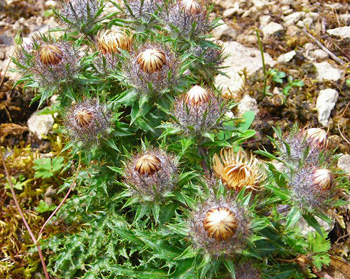Contents:
Common Names | Parts Usually Used | Plant(s) & Culture | Where Found | Medicinal Properties
Legends, Myths and Stories | Uses | Formulas or Dosages | Bibliography
Scientific Names

- Carlina acaulis L.
- Compositae
- Composite family
Common Names
- Dwarf carline
- Ground thistle
- Southernwood root
Parts Usually Used
Root
Back to Top
Description of Plant(s) and Culture
Carline thistle is a European perennial plant; the finger-thick rootstock is brown on the outside, lighter and fissured on the inside, and has an unpleasant, pungent odor when fresh but an aromatic odor when dried. The lanceolate, sharply incised leaves, similar to dandelion leaves, are radially arranged in a circle on the ground. A single, large, stemless flower, with a creamy-white center and silvery-white, petal-like bracts, sits immediately on top of the rosette of leaves.
Back to Top
Where Found
Found on slopes, waste land, pastures, preferring limestone soils.
Back to Top
Medicinal Properties
Carminative, diaphoretic, digestive, diuretic, febrifuge
Back to Top
Legends, Myths and Stories
In the Middle Ages, an angel was supposed to have shown Charlemagne how to use carline thistle against an epidemic of the plague which was killing his soldiers. Therefore, this herb was named after Charlemagne, whose name in German was Karl der Grosse, or Carl the Great.
In medieval beliefs, this thistle could draw strength from other people and even animals, to the person carrying the herb. Another belief was; by eating a cooked carline thistle root a man could gain the sexual strength and potency of a stallion. For this to be effective, the root had to be grown and prepared according to a prescribed ritual which included planting and harvesting it only under a new moon at the stroke of midnight and fertilizing it with the sperm of a black stallion.
Even today, some rural Germans believe that carrying a carline thistle will protect them from harm. It is regarded as a weather predictor; the flower closes when the air becomes more humid, which is usually the indication of rain and bad weather.
Back to Top
Uses
Large doses are emetic and purgative. Recommended for kidney and stomach problems, dropsy, impotence, fever related to gastric problems. Its present use is mostly external; the root applied externally is said to remove scars. A decoction of the root prepared with white wine or wine vinegar is used for washing wounds and for skin problems.
Back to Top
Formulas or Dosages
Infusion: use 6 tsp. rootstock with 1 cup water. Take 1-2 cups a day.
Decoction: use 1 tsp. rootstock to 1/2 cup water; boil briefly. Take 1 to 1 1/2 cups a day, a mouthful at a time.
Tincture: take 10 drops on a sugar cube or in water, 3 times a day.
Powder: take 1/4 to 1/2 tsp. in water, 2 or 3 times a day.
Back to Top
Bibliography
![]() Culpeper’s Complete Herbal & English Physician: Updated With 117 Modern Herbs
Culpeper’s Complete Herbal & English Physician: Updated With 117 Modern Herbs, by Nicholas Culpeper, Meyerbooks, publisher, PO Box 427, Glenwood, Illinois 60425, 1990, (reprint of 1814)
![]() The Herb Book
The Herb Book, by John Lust, Bantam Books, 666 Fifth Avenue, New York, NY. copyright 1974.
 How Indians Use Wild Plants for Food, Medicine & Crafts
How Indians Use Wild Plants for Food, Medicine & Crafts, by Frances Densmore, Dover Publications, Inc., 180 Varick Street, New York, NY 10014, first printed by the United States Government Printing Office, Washington, in 1928, this Dover edition 1974
 The Magic of Herbs
The Magic of Herbs, by David Conway, published by Jonathan Cape, Thirty Bedford Square, London, England. (Out of print)
![]() Planetary Herbology
Planetary Herbology, by Michael Tierra, C.A., N.D., O.M.D., Lotus Press, PO Box 325, Twin Lakes. WI 53181., Copyright 1988, published 1992
![]() Webster’s New World Dictionary
Webster’s New World Dictionary, Third College Edition, Victoria Neufeldt, Editor in Chief, New World Dictionaries: A Division of Simon & Schuster, Inc., 15 Columbus Circle, New York, NY 10023
